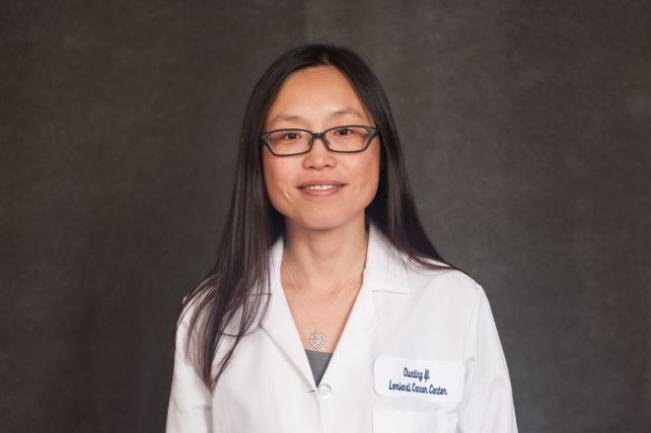Team Led by Award-Winning Researcher Finds Pro-Cancer Protein Can Also Be Protective

Posted in Lombardi Stories | Tagged cancer research
November 4, 2016 — Inflammation can be both friend and foe when it comes to a certain kind of cancer, according to a team led by an award-winning researcher at Georgetown Lombardi Comprehensive Cancer Center. Their findings indicate that over-the-counter antioxidants should be used with a great deal of caution.
Chunling Yi, PhD, assistant professor at Georgetown and recent recipient of the Georgetown Lombardi Rising Star Research Award, led the study, which was published online on November 3 in Developmental Cell. Notably, the two co-first-authors, Yuhao Shi and Saumya Bollam, are two former Georgetown undergraduates who spent a large part of their time at Georgetown doing research in Yi’s lab. The study shows that inflammation can slow early development of cancer linked to a mutant gene, but once tumors are established, inflammation speeds up their growth.
“Inflammation is a double-edged sword. We have known it can have ill effects as well as positive ones, but this study demonstrates how inflammation switches from fighting cancer to aiding and abetting it,” says Yi. She adds that the powerful antioxidants used in supplements designed to fight inflammation — for example, vitamin E and N-acetylcysteine (NAC) — may accelerate cancer growth in certain conditions.
Yi and her co-authors found that these antioxidants suppress development of reactive oxygen species (ROS), which can cause DNA damage and trigger an immune response. In early cancer development, this inflammation may help slow tumor growth by pushing cancer cells to die due to damage.
But some cancers are good at reprogramming an immune response to help tumors survive and thrive, and antioxidant supplements may work like gas to speed cancer growth, Yi says. “My message is that inflammation is extremely complex, and it would be best not to tweak it with over-the-counter agents.”
Relatively Rare, but Involved in Many Cancer Types
Yi’s research focuses on two separate but linked pathways involved in cancers caused, in part, by mutations in the Neurofibromin 2 (NF2) gene. NF2 is known to be a tumor suppressor, but if it is mutated, it cannot produce its beneficial protein, known as merlin.
Cancers linked to NF2 mutations include neurofibromatosis type 2, a multiple tumor forming disease of the nervous system that usually afflicts children, as well as schwannomas (loss of hearing), bile duct cancer, liver cancer and, infrequently, cancers of the prostate, brain and colon.
Yi studies two NF2 pathways – one linked to Yes-associated protein (Yap) and another that features Ras-related botulinum toxic substrate 1 (Rac1). In 2014, she reported in Science Signaling that suppressing Yap, an oncogene, stopped growth of pancreatic cancer.
This study looks at the function of Rac1 in mouse models of human bile duct cancer caused by a NF2 mutation.
Both Oncogene and Tumor Suppressor
Rac1 had been thought to be an oncogene, but the investigators found that it can also work as a growth suppressor. The normal role of NF2 is to inhibit Rac1 to keep inflammation in check, but if NF2 is mutated, Rac1 can produce excess ROS, spurring inflammation, Yi says.
The researchers found in their mice that if Rac1 is depleted, tumor cells grew faster. “This was very unexpected. It led to our discovery that Rac1 activates ROS production, which stimulates inflammation that inhibits tumor growth,” Yi says.
On the other hand, Rac1 activation could protect against tumor growth. “Our cells have the capacity to resist tumor development. In some conditions when NF2 is lost, Rac1 appears to act as almost like a tumor suppressor,” she says.
Yi adds that this discovery may lead to a novel cancer treatment. “Rac1 acts as a key inflammation switch in NF2 mutant tumors. An anti-tumor function switches to pro-tumor growth at a certain point in cancer growth, and it could be possible to design an agent that prohibits turning the pro-growth switch on.”
The Yap pathway has turned out to be one of the central cancer pathways underlying many types of common as well as rare cancers, as seen in Yi’s prior discovery that Yap could be the Achilles heel in pancreatic cancer. She says that efforts are underway by pharmaceutical companies to design drugs that inhibit the protein in a number of cancers.
“Effective treatment of NF2 mutant cancers may require both Yap and Rac1 inhibitors,” Yi says. “The idea is to shut down the entire NF2 cancer growth pathway.”
Renee Twombly
GUMC Communications
